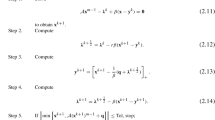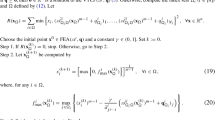Abstract
In this paper, we consider a class of tensor least squares problem with an invertible linear transform, which arises in image restoration. Based on the operator-bidiagonal procedure, two Paige’s algorithms are designed to solve it. The convergence theorems of the new methods are derived. Numerical experiments are performed to illustrate the feasibility and efficiency of the new methods, including when the algorithm is tested with the synthetic data and on some image restoration problems. Comparisons with some previous methods are also given.
Access this article
We’re sorry, something doesn't seem to be working properly.
Please try refreshing the page. If that doesn't work, please contact support so we can address the problem.








Similar content being viewed by others
Data Availability
The data used to support the findings of this study are included within the article.
Notes
When we use an algorithm to solve the ill-posed problem, the algorithm exhibits a gradual convergence behavior for the first k iterations. However, after the kth step, the error will increase and the convergence will disappear. This is called "semi-convergence".
Set \({{\mathscr {X}}}_k\) be the kth iterative value of an algorithm. If the noise \({\mathscr {E}}\) satisfies \(\Vert {{\mathscr {E}}}\Vert _F \le \Vert {{\mathscr {A}}}{*_L}{{\mathscr {X}}}_k - {{{\mathscr {B}}}}\Vert _F\), it is called as a low noise level. Conversely, if \({\mathscr {E}}\) satisfies \( \Vert {{\mathscr {E}}}\Vert _F > \Vert {{\mathscr {A}}}{*_L}{{\mathscr {X}}}_k - {{{\mathscr {B}}}}\Vert _F \), it is called as a high noise level.
References
Bader, B.W., Kolda, T.G., et al.: Tensor Toolbox for MATLAB, Version 3.2.1, https://www.tensortoolbox.org
Behera, R., Mishra, D.: Further results on generalized inverses of tensors via the Einstein product. Linear Multilinear Algebra 65, 1662–1682 (2017)
Behera, R., Sahoo, J.K., Mohapatra, R.N., et al.: Computation of generalized inverses of tensors viat-product. Numer. Linear Algebra Appl. 29, 1–23 (2022)
Birgin, E.G., Martínez, J.M., Raydan, M.: Nonmonotone spectral projected gradient methods on convex sets. SIAM J. Optim. 10, 1196–1211 (2000)
Bouhamidi, A., Jbilou, K., Raydan, M.: Convex constrained optimization for large-scale generalized Sylvester equations. Comput. Optim. Appl. 48, 233–253 (2011)
Brazell, M., Li, N., Navasca, C., et al.: Solving multilinear systems via tensor inversion. SIAM J. Matrix Anal. Appl. 34, 542–570 (2013)
Bykov, V.I., Kytmanov, A.M., Lazman, M.Z., et al.: Elimination Methods in Polynomial Computer Algebra. Kluwer Academic Publishers, The Netherlands (1998)
Cao, Z., Xie, P.: Perturbation analysis for \(t\)-product based tensor inverse, Moore-Penrose inverse and tensor system, arXiv preprint arXiv:2107.09544 (2021)
Chen, Z., Lu, L.Z.: A projection method and Kronecker product preconditioner for solving Sylvester tensor equations. Sci. China Math. 55, 1281–1292 (2012)
Cui, L.B., Chen, C., Li, W., et al.: An eigenvalue problem for even order tensors with its applications. Linear Multilinear Algebra 64, 602–621 (2016)
Dehdezi, E.K., Karimi, S.: A fast and efficient Newton-Shultz-type iterative method for computing inverse and Moore-Penrose inverse of tensors. J. Math. Model. 9, 645–664 (2021)
Ding, W.Y., Wei, Y.M.: Solving multi-linear systems with M-tensors. J. Sci. Comput. 68, 689–715 (2016)
Ely, G., Aeron, S., Hao, N., et al.: 5D and 4D pre-stack seismic data completion using tensor nuclear norm. TNN, SEG International Exposition and Eighty-Third Annual Meeting at Houston, TX (2013)
Golub, G., Kahan, W.: Calculating the singular values and pseudo-inverse of a matrix. J. Soc. Industr. Appl. Math. 2, 205–224 (1965)
Golub, G.H., Heath, M., Wahba, G.: Generalized cross-validation as a method for choosing a good ridge parameter. Technometrics 21, 215–223 (1979)
Guide, M.E., Ichi, A.E., Jbilou, K.: Discrete cosine transform LSQR and GMRES methods for multidimensional ill-posed problems, arXiv preprint arXiv:2103.11847 (2021)
Guide, M.E., Ichi, A.E., Jbilou, K.: Discrete cosine transform LSQR methods for multidimensional ill-posed problems. J. Math. Model. 10, 21–37 (2022)
Guide, M.E., Ichi, A.E., Jbilou, K., et al.: Tensor Krylov subspace methods via the T-product for color image processing, arXiv preprint arXiv:2006.07133 (2020)
Guide, M.E., Ichi, A.E., Beik, F.P., et al.: Tensor GMRES and Golub-Kahan Bidiagonalization methods via the Einstein product with applications to image and video processing, arXiv preprint arXiv:2005.07458 (2020)
Hansen, P.C., Nagy, J.G., O’leary, D.P.: Deblurring Images: Matrices, Spectra, and Filtering. SIAM, Philadelphia (2006)
Hao, N., Kilmer, M.E., Braman, K., et al.: Facial recognition using tensor-tensor decompositions. SIAM J. Imaging Sci. 6, 437–463 (2013)
Huang, B.: Numerical study on Moore-Penrose inverse of tensors via Einstein product. Numer. Algorithms 87, 1767–1797 (2021)
Huang, B., Ma, C.: An iterative algorithm to solve the generalized Sylvester tensor equations. Linear Multilinear Algebra 68, 1175–1200 (2020)
Huang, B., Ma, C.: Global least squares methods based on tensor form to solve a class of generalized Sylvester tensor equations. Appl. Math. Comput. 369, 1–16 (2020)
Iusem, A.N.: On the convergence properties of the projected gradient method for convex optimization. Comput. Appl. Math. 22, 37–52 (2003)
Karimi, S., Dehghan, M.: Global least squares method based on tensor form to solve linear systems in Kronecker format. T. I. Meas. Control 40, 2378–2386 (2018)
Kernfeld, E., Kilmer, M., Aeron, S.: Tensor-tensor products with invertible linear transforms. Linear Algebra Appl. 485, 545–570 (2015)
Kilmer, M.E., Martin, C.D.: Factorization strategies for third-order tensors. Linear Algebra Appl. 435, 641–658 (2011)
Kilmer, M.E., Horesh, L., Avron, H., et al.: Tensor-tensor algebra for optimal representation and compression of multiway data. Proc. Natl. Acad. Sci. 118, e2015851118 (2021)
Kolda, T.G., Bader, B.W.: Tensor decompositions and applications. SIAM Rev. 51, 455–500 (2009)
Liu, X., Wang, L., Wang, J., et al.: A three-dimensional point spread function for phase retrieval and deconvolution. Opt. Express 20, 15392–15405 (2012)
Paige, C.C.: Bidiagonalization of matrices and solution of linear equations. SIAM J. Numer. Anal. 11, 197–209 (1974)
Polyak, B.T.: The conjugate gradient method in extremal problems. USSR Comp. Math. Math. Phys. 9, 94–112 (1969)
Reichel, L., Ugwu, U.O.: The tensor Golub-Kahan-Tikhonov method applied to the solution of ill-posed problems with a \(t\)-product structure. Numer. Linear Algebra Appl. 29, e2412 (2022)
Reichel, L., Ugwu, U.O.: Tensor Krylov subspace methods with an invertible linear transform product applied to image processing. Appl. Numer. Math. 166, 186–207 (2021)
Savas, B., Eldén, L.: Krylov-type methods for tensor computations. Linear Algebra Appl. 438, 891–918 (2013)
Sun, L., Zheng, B., Bu, C., et al.: Moore-Penrose inverse of tensors via Einstein product. Linear Multilinear Algebra 64, 686–698 (2016)
Sun, L., Zheng, B., Wei, Y., et al.: Generalized inverses of tensors via a general product of tensors. Front. Math. China 13, 893–911 (2018)
Wang, Q.W., Xu, X., Duan, X.: Least squares solution of the quaternion Sylvester tensor equation. Linear Multilinear Algebra 69, 104–130 (2021)
Xie, Z.J., Jin, X.Q., Sin, V.K.: An optimal preconditioner for tensor equations involving Einstein product. Linear Multilinear Algebra 68, 886–902 (2020)
Zhang, Z., Ely, G., Aeron, S., et al.: Novel methods for multilinear data completion and de-noising based on tensor-SVD. In: Proceedings of the IEEE Conference on Computer Vision and Pattern Recognition, pp. 3842–3849 (2014)
Acknowledgements
The authors thank the editor and the reviewers for the constructive and helpful comments on the revision of this article.
Author information
Authors and Affiliations
Corresponding author
Ethics declarations
Conflicts of interest
This study does not have any conflicts to disclose.
Additional information
Publisher's Note
Springer Nature remains neutral with regard to jurisdictional claims in published maps and institutional affiliations.
This work was supported by the National Natural Science Foundation of China (Grant No. 12361079; 12201149; 12261026; 12371023), the Natural Science Foundation of Guangxi Province (Grant No. 2023GXNSFAA026067), and the Innovation Project of GUET Graduate Education (Grant No. 2022YCXS147; 2022YCXS140).
Rights and permissions
Springer Nature or its licensor (e.g. a society or other partner) holds exclusive rights to this article under a publishing agreement with the author(s) or other rightsholder(s); author self-archiving of the accepted manuscript version of this article is solely governed by the terms of such publishing agreement and applicable law.
About this article
Cite this article
Duan, XF., Zhang, YS., Wang, QW. et al. Paige’s Algorithm for solving a class of tensor least squares problem. Bit Numer Math 63, 48 (2023). https://doi.org/10.1007/s10543-023-00990-y
Received:
Accepted:
Published:
DOI: https://doi.org/10.1007/s10543-023-00990-y




